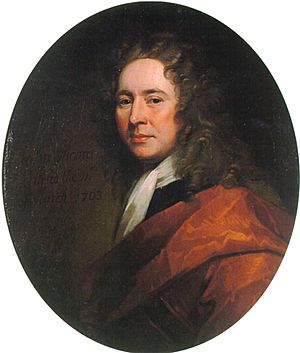John Monro (surgeon) facts for kids
John Monro (1670–1740) was a Scottish surgeon. He is famous for starting a family of important doctors in Edinburgh, called the Monro dynasty. He also played a big part in creating the University of Edinburgh Medical School. He was the head (Deacon) of the Incorporation of Surgeons of Edinburgh, which was a group for surgeons.
Contents
Learning to Be a Surgeon
John Monro was the third son of Sir Alexander Monro. In 1687, John started learning to be a surgeon. He trained with William Borthwick, an Edinburgh surgeon. Borthwick had studied medicine in other countries, like Italy and Holland.
This international experience influenced young John. From 1689, Monro also learned from Dr. Christopher Irvine. Irvine had earned his medical degree abroad. In 1692, Monro went to Leiden University in Holland. There, he attended lectures by Archibald Pitcairne, a professor from Edinburgh.
Military Career
In 1694, John Monro came back home. He married his cousin, Jean Forbes. In 1695, he became a surgeon in General Sir Henry Belasyse's 22nd Regiment of Foot.
That spring, his regiment served in the Netherlands. They were in a camp between Bruges and Ghent. Later that year, they helped in the Siege of Namur. King William III of Great Britain led this battle.
From 1696 to 1700, Monro was stationed in England and Ireland. But he often had long breaks. This allowed him to live in London with his wife. Their son, Alexander Monro, was born there in 1697. In 1700, John Monro left the army. He then settled in Edinburgh.
Becoming a Leading Surgeon
To work as a surgeon, John Monro first opened a shop selling medicines. He became a citizen of Edinburgh in 1702. In 1703, he joined the Incorporation of Surgeons after passing his exams.
Monro was elected as Treasurer (Boxmaster) from 1708 to 1710. In 1712, he became the head (Deacon) of the Incorporation. This role gave him a seat on the Edinburgh Town Council. Later that year, he was also elected Deacon of the Edinburgh Convenery of Trades. This position gave him a lot of local power.
The next year, he was re-elected to these roles. He was also chosen to represent the city at a meeting of Scottish towns. In 1713, the Town Council hired him as surgeon for the city's poor. He held this job until 1720.
His Role in Starting Edinburgh Medical School
John Monro became a very important person in Edinburgh. He then worked to achieve his big dream. He wanted to create a "Seminary of Medical Education" in the city. This school would be like the one at Leiden University where he had studied.
In 1720, he shared his plan. He said he had "long formed in my own mind" this idea. Everyone liked his plan. This included the Town Council, the University of Edinburgh, and the Incorporation of Surgeons.
The most important part of his plan was to appoint his son, Alexander, as Professor of Anatomy. John Monro had carefully planned Alexander's education for this goal. Alexander had studied in Edinburgh, London, Paris, and Leiden. He had one of the best medical educations of his time.
To help his son get this job, John Monro used his influence. In 1720, he convinced the two current anatomy professors to resign. They said they could not teach properly due to their health. They suggested Alexander Monro for the job. The next week, Alexander was appointed Professor of Anatomy at the University.
In the following months, John Monro helped arrange other appointments. Charles Alston became Professor of Materia Medica (study of medicines). James Crawford became Professor of Chemistry. These appointments and the lectures that followed started the Edinburgh University Medical School.
Family and the Anatomy Dynasty
John Monro married twice. In 1694, he married his first cousin, Jean Forbes. They had one son, Alexander Monro primus (1697–1767).
Alexander Monro primus's son, Alexander Monro secundus (1733–1817), also became a Professor of Anatomy. And his son, Alexander Monro tertius (1773–1859), held the same job. These three men taught anatomy for a total of 126 years, from 1720 to 1846.
Jean Monro died around 1710. In 1721, John Monro married Margaret Main. She lived longer than him. In his later years, he lived at Carolside in Berwickshire. He died there in 1740.


